
In preparing a session with colleagues regarding the affects of COVID-19 on educators, families, and students, I began to become disheartened about the negative impacts of stress and trauma. I became increasingly concerned about the wellbeing of those I serve, and also reflected on my own emotional and physiological response to the pandemic’s disruptions to my life. The green ribbon on my bitmoji represents mental health awareness. As educators, it is vital we advocate for the mental health of ourselves and those we serve, particularly at a time when mental health organizations report a surge of requests for support.
Social isolation can cause loneliness. Financial struggles and domestic disputes in families quarantined can increase stress. These stressors impact both mental and physical health, and also result in struggles with learning and memory. The more I read about the effects of the pandemic, the more anxious I became regarding my own mental and physical health.
Click here to view curated resources regarding impacts of COVID-19, and social-emotional learning (SEL) strategies to support educators and students at this time of uncertainty.
While educators cannot remove these outside forces, the brain is built to repair itself. By implementing simple strategies based on brain research, we can have a positive influence toward mental health for ourselves, our colleagues, and our students.
Universal Design for Learning (UDL), based on neuroscience, provides a framework of strategies meant to activate specific networks of the brain. This has become increasingly valuable during this time. UDL guideline 9, Provide Options for Self Regulation, aligns to SEL competency Self Management. The strategies below are based on foundational principles of the UDL checkpoint and SEL competency, and can be embedded in to daily instruction. I use many of these self-management tactics myself, thereby lessoning my anxiety and increasing the dopamine in my brain to positively affect productivity.
Pomodoro Technique: Learning in Chunks –
The pomodoro technique, developed by Francesco Cirillo in the 1980s, encourages us to break up learning tasks into chunks of time. I use this strategy myself.
1) Create a list of tasks to be done. (Excellent for educators as well as students).
2) Set a timer for 25 minutes, then take a break for 5 minutes. Loop this time pattern. (I have found this especially helpful when leading professional learning sessions for administrators. They are more likely to focus on the learning at hand when they know there will be a 5 minute break to check email, etc. every 25 minutes).

3) Make a checkmark for each 25 minutes, as well as for each task completed. After four 25 minute segments, take a 15-30 minute break.
Organization & Project Management –
We often make the false assumption that students should be able to get organized and manage time appropriately. As a young educator, I would become frustrated with students whose desk was filled with unorganized papers or did not keep up with deadlines for a large project. But behavior is communication, and often organizational skills and project management strategies must be explicitly taught. We can scaffold this process for students to build their capacity toward self-management in these areas.
1) Leverage digital calendars. If your students use Google Classroom for example, assignments with due dates are automatically added to the Google calendar for their account. Many students and educators are unaware of this automated feature. Remind students to look at their calendar to become aware of upcoming deadlines.
2) Automate reminders. I know educators that ask students to create a note with learning tasks to complete (using Google Keep or another mobile app on their phone), and then set a notification for a time they plan to work on the task(s). This is a life skill that students can use in the future as they enter the career world.
3) Manage projects digitally. Apps such as trello allow students to communicate and assign tasks when working in groups, even when they are not physically present with one another. Google Sheets now feature an option to add checklists, and the comments feature includes an “assign” option to automate an email reminder of a task to be completed.

Mental health IS physical health. In implementing simple strategies into the virtual or on-campus classroom, students ability to learn and remember content is greatly increased. I encourage you to test out one or many of these strategies, both for yourself and your students. While the environment of learning has shifted, we can make a positive impact on the lives of our colleagues and students.
